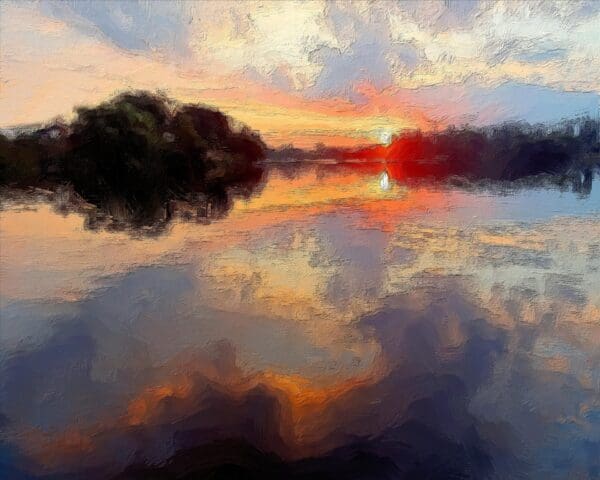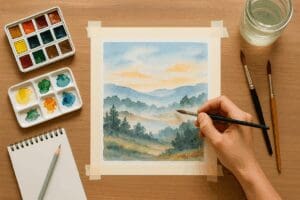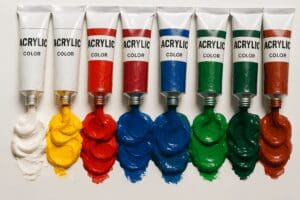Creating Atmospheric Perspective in Landscape Painting
-
What is Atmospheric Perspective? Atmospheric perspective refers to the technique of using visual cues to create the illusion of depth in a landscape. It is based on the observation that objects in the distance appear lighter, less saturated, and less detailed due to the effects of the atmosphere. This is an essential technique for artists to master when working with landscapes.
-
Importance in Landscape Painting Mastering atmospheric perspective helps artists convey a sense of space, distance, and the changing qualities of light in their work. It allows artists to transform a flat canvas into a dynamic, three-dimensional scene.
1. The Role of Color Fading
-
Understanding Color and Depth As objects recede into the distance, the colors become cooler and less saturated. This is due to the scattering of light in the atmosphere, which reduces the intensity of distant colors. Artists can mimic this by gradually lightening and cooling the colors in the background of a landscape.
-
Techniques for Color Fading
-
Use of Cool Colors: As the distance increases, warm colors like reds and yellows are replaced by cool colors like blues and purples. This helps the farthest elements of the landscape recede.
-
Gradation: Gradually transition from warm, saturated hues in the foreground to lighter, cooler tones in the background to enhance depth.
-
Examples of Color Fading in Landscapes: Look at how iconic landscape painters like J.M.W. Turner or Claude Monet used color fading in their works.
-
-
Practical Tips:
-
Begin with rich, warm tones for foreground elements like trees, fields, or rocks.
-
Use lighter shades of blues and purples for distant mountains or skies.
-
Avoid overly sharp contrasts in the background; let the colors fade gently into one another.
-
2. Diminishing Detail to Create Depth
-
Why Detail Fades with Distance As objects recede, they appear less distinct due to atmospheric conditions like mist, haze, and the dispersal of light. The farther away an object is, the less detail it retains, and the softer it becomes.
-
Techniques for Diminishing Detail
-
Focus on Foreground: Keep the details crisp and defined in the foreground to create a sense of clarity and realism.
-
Simplify the Background: As you move toward the horizon, reduce the level of detail. This could involve simplifying shapes, textures, and forms.
-
Use of Soft Brushes: In the background, soft brushwork can blur the edges and reduce the detail in distant objects, enhancing the sense of depth.
-
-
Practical Tips:
-
In the foreground, include specific details like individual leaves, textures, or reflections in water.
-
In the middle and far distances, blur the shapes of trees or rocks to reduce sharpness and maintain a sense of atmospheric fading.
-
Avoid painting every leaf or blade of grass in the distance; instead, focus on creating the impression of a natural scene.
-
3. Aerial Perspective: Understanding the Science
-
What is Aerial Perspective? Aerial perspective is a technique used to show the effects of the atmosphere on objects in the distance. The particles in the air scatter light, making objects appear lighter and less saturated with detail. It is the foundation of creating a realistic sense of space and depth.
-
How Light and Air Affect Distant Objects
-
Increased Haze and Light Scattering: As light travels through the air, particles scatter it, causing distant objects to appear softer and lighter.
-
The Role of Contrast: Distant objects tend to have less contrast with the sky, especially in hazy or foggy conditions, which reduces their clarity.
-
-
Using Aerial Perspective in Your Work
-
Layering Colors: Apply progressively lighter and cooler colors as you paint further into the background.
-
Reduce Contrast: The contrast between light and shadow will be less intense in the background. Avoid deep shadows in distant hills or mountains.
-
Create the Illusion of Distance: Use fading contrasts and lighter hues to draw the eye into the distance.
-
-
Practical Tips:
-
For distant mountains, use soft washes of cool, light colors and reduce sharpness.
-
Avoid heavy texture or highly defined lines in the background. Use smoother, lighter brushstrokes instead.
-
Apply layers of thin washes of color to build up a sense of fading.
-
4. Combining Techniques for Maximum Impact
-
Balancing the Techniques for a Natural Effect Atmospheric perspective isn’t about relying on a single technique. The most effective landscapes often use a combination of color fading, diminishing detail, and aerial perspective. By layering these methods, you can create a cohesive, immersive scene that feels like it exists in real space.
-
Creating a Dynamic Composition
-
Use foreground detail and contrast to anchor the viewer’s attention.
-
Gradually fade the detail and colors as you move towards the background, using these techniques to guide the viewer’s eye into the painting.
-
Consider the natural progression of light and air in your chosen landscape. Realistic atmospheric effects can be inspired by the natural world around you.
-
-
Practical Tips for Combining Techniques:
-
Think about the “atmosphere” of the scene. For a misty morning, use more fading and softer details.
-
For a clearer day, you can push the contrast between foreground and background further but still incorporate color fading and diminished detail.
-
Conclusion
-
Recap the Key Techniques Atmospheric perspective is an essential tool for creating depth in landscape paintings. By using color fading, diminishing detail, and aerial perspective, artists can craft paintings that feel expansive and lifelike.
-
Encouragement for Artists Atmospheric perspective requires practice, but once mastered, it can greatly enhance the realism and mood of your work. Experiment with these techniques and see how they transform your landscapes.
*For collaborations, art features, or inquiries, please contact us at in**@**********rt.ie. Don’t forget to follow us on Instagram, Facebook, Twitter.
Disclaimer: The views and opinions expressed in this article do not necessarily reflect the official policy or position of Irish Artmart.
Irish Artmart – Your Gateway to Artistic Excellence.
Image by Johnny Gunn from Pixabay





